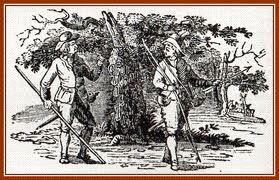About half a mile north of the Asda supermarket at Minworth lies Peddimore Hall, surrounded by its moat. This is not the original building, as Sir William Dugdale observed in his Antiquities of Warwickshire published in 1656: “Here is now no more remaining of an ancient manor place that the Ardens had than a large double moat, for after they settled in these parts, having another house on the south side of Tame called Park Hall they resided for the most part there and let this go to ruin”. Robert, the last of the Ardens, died in 1643, then in about 1660 William Wood purchased Peddimore from Robert’s sisters and by 1663 he had built a new hall on the site.
The first documentary reference to Peddimore is dated 1281, but it had probably come into being over a hundred years before that. In1281 the Manor of Peddimore in Sutton Coldfield came to Thomas Arden of Hanwell (near Banbury in Oxon) and Roese his wife. (Rose was the daughter of Ralph de Vernon, lord of the manor of Hanwell). Thomas, says Dugdale, “began to take the same liberty here as he did in his other properties, not considering that it was within the compass of Sutton Chase” where the Earl of Warwick had right to the vert and venison according to Forest Law.
Warwick began legal proceedings against Arden, but Thomas was happy to reach an out of court settlement in 1288, the terms of the agreement showing how restrictive life in the Chase could be. Thomas was still not allowed to hunt game in the Chase, or to graze sheep (sheep and deer were incompatible), but the Earl made a number of concessions.
“Vert” means the vegetation growing in the Chase, giving cover and sustenance to the deer and wild boars, “venison” being the wild creatures which could be hunted or trapped. Under the agreement, Thomas and Roese were permitted to gather wood for hedges and for firewood for their own use, and to sell wood worth not more than £20, subject to the oversight of the Earl of Warwick’s Forester “to the end that the Chase may have least prejudice thereby” - the ordinary inhabitants of Sutton Coldfield enjoyed a similar privilege. William de Beauchamp Earl of Warwick also granted permission for felling of timber to repair buildings, subject to the approval of the Forester, or of the Earl’s Bailiff at Sutton, or of two neighbours.
The Ardens had extensive lands in Curdworth and Minworth (also within the bounds of Sutton Chase) in addition to Peddimore, with sufficient woodland to warrant the employment of a woodward - the agreement requires the woodward swear an oath to the Earl that he will not interfere with the venison, carrying only a hatchet and leaving his bow and arrows at home.
Arden’s hogs would be allowed to forage in the woods of Peddimore and Curdworth, and he could beat down acorns for his swine and gather nuts and other fruit.
As to venison, the Earl apparently claimed fishing rights in all the streams in the Chase, as he agrees that the Ardens may fish in “that little stream called Ebrook” when they reside at Peddimore so far as their lands lie adjacent to it. Permission was also granted to bring new land into cultivation, twenty acres at a time, making his hedges and fences such that does with their fawns might leap over them. Local people had grazing rights in the Chase, and any new land had to be thrown open to grazing cattle once the crops had been harvested (deer could co-exist with cattle).
